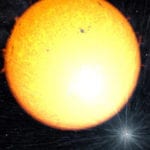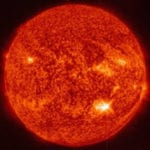 Technology
Technology  Technology
Technology  Humans
Humans 10 Everyday Human Behaviors That Are Actually Survival Instincts
 Animals
Animals 10 Animals That Humiliated and Harmed Historical Leaders
 History
History 10 Most Influential Protests in Modern History
 Creepy
Creepy 10 More Representations of Death from Myth, Legend, and Folktale
 Technology
Technology 10 Scientific Breakthroughs of 2025 That’ll Change Everything
 Our World
Our World 10 Ways Icelandic Culture Makes Other Countries Look Boring
 Misconceptions
Misconceptions 10 Common Misconceptions About the Victorian Era
 Mysteries
Mysteries 10 Strange Unexplained Mysteries of 2025
 Miscellaneous
Miscellaneous 10 of History’s Most Bell-Ringing Finishing Moves
 Technology
Technology Top 10 Everyday Tech Buzzwords That Hide a Darker Past
 Humans
Humans 10 Everyday Human Behaviors That Are Actually Survival Instincts
 Animals
Animals 10 Animals That Humiliated and Harmed Historical Leaders
Who's Behind Listverse?

Jamie Frater
Head Editor
Jamie founded Listverse due to an insatiable desire to share fascinating, obscure, and bizarre facts. He has been a guest speaker on numerous national radio and television stations and is a five time published author.
More About Us History
History 10 Most Influential Protests in Modern History
 Creepy
Creepy 10 More Representations of Death from Myth, Legend, and Folktale
 Technology
Technology 10 Scientific Breakthroughs of 2025 That’ll Change Everything
 Our World
Our World 10 Ways Icelandic Culture Makes Other Countries Look Boring
 Misconceptions
Misconceptions 10 Common Misconceptions About the Victorian Era
 Mysteries
Mysteries 10 Strange Unexplained Mysteries of 2025
 Miscellaneous
Miscellaneous 10 of History’s Most Bell-Ringing Finishing Moves
10 Terrible Acts of Mother Nature
For years now, we have suffered unremitting lectures on how mankind is ruining its chance of a future due to its indiscriminate disposal of waste, and excessive reliance upon fossil fuels. This is just a small reminder that, when in a bad mood, Old Mother Nature can do more harm to the fragile human race in the blink of an eye than men can do to themselves in over a century of industrial pollution. Her advantage is, she has the time and the talent to remake everything again. Natural catastrophes have always played a part in this planets history, but I don’t intend to comment on those still fresh in peoples minds. In chronological order:
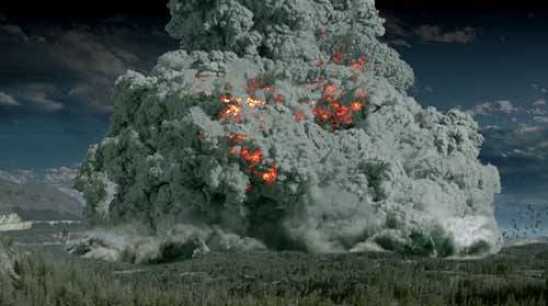
Biped humanoids first appeared several million years ago, but the modern variety, Homo sapiens, hadn’t been around too long before they were almost wiped out. About 75,000 years ago, Lake Toba, in Indonesia, erupted in a super volcanic event, described by many scientists as ‘mega-colossal’. The event is believed to have been the largest explosive eruption anywhere on earth in the last 25 million years, and it was so immense it came very close to calling time-out for the burgeoning human race.
Up to 6,000 cubic kilometers of ash – enough to cover the entire USA to a depth of 70cm – jetted into the atmosphere. It took place in a part of the world fairly thin in habitation at that time, but its discharge of vast amounts of noxious sulphur dioxide, and a deposit of ash 25 centimeters thick, destroyed all the lush forests of south-east Asia, while dust clouds blocked sunlight and plunged the entire planet into an estimated 6 to 10 year volcanic winter.
There was worldwide destruction of vegetation and severe drought in all tropical rain forests, and entire groups of animals became eliminated. Some people believe this may have resulted in humans world-wide being reduced to just a few thousand individuals, surviving mostly in Africa, with a core of perhaps only 10,000 breeding pairs. This bottleneck in human evolution, they say, could have been responsible for the very small residual gene pool in the world’s population now.
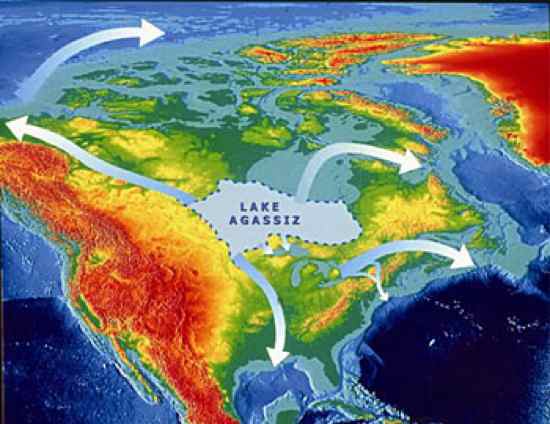
The world has seen countless awesome flood events, for instance meltwater from retreating glaciers at the end of the last ice age created the Caspian Sea and the Black Sea as vast freshwater lakes. Around 8500 BC, the massive Lake Agassiz in North America – the worlds largest ever freshwater lake – was still filling with meltwater from the colossal American ice sheets. This lake – of which the present day Great Lakes are only a remnant – was about 2000km in length – a virtual inland freshwater sea – stretching from Hudson Bay in northern Canada, as far south as Minnesota in the present day USA.
Eventually the lake could hold no more water from the thawing ice, and when it burst its banks, about 30 per cent more water than contained in all the worlds lakes today blasted into the North Atlantic. The surge of fresh water was so dramatic it disrupted the warm Gulf Stream current in the ocean, and caused a 400 year dip in world temperatures, plunging the planet into another brief ice age. Afterwards, rapid global warming led to a phenomenal rise in sea levels – more then 30 meters.
Around 5600 BC, the Mediterranean Sea cascaded over the Bosporus sill, which was dry land until then, and transformed the freshwater Black Sea into a vast salt water inlet. Geologists claim that ‘ten cubic miles of water poured into the Black Sea for about 300 days’ – which is 200 times greater than goes over Niagara Falls today.
More than 600,000 square miles of land was flooded, triggering mass migrations of animals and people across Europe and Asia. It may be that some of the people fleeing westward were the first to introduce farming into Europe. The earliest traces of European agriculture are to be found in the southeast region of the continent.
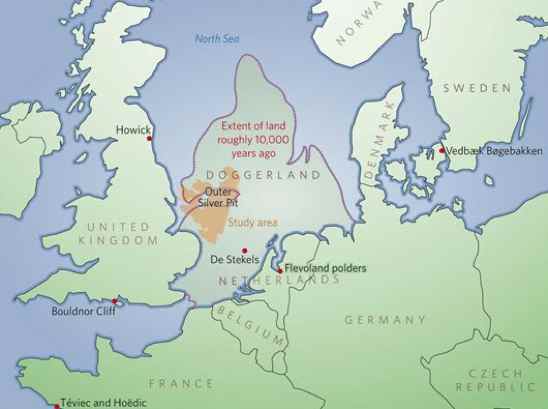
Until 6100 BC, Britain had been linked to Europe by a broad land bridge of chalk downland running from Kent to the Vale of York, and eastwards towards Denmark, and for 4,000 years people moved back and forth across it on hunting trips. This region is referred to as ‘Doggerland’ by scientists (a compliment to the Dogger Bank, which lays beneath the North Sea). There was a river running through it – the river of Nord – that the Thames, the Rhine and the Seine all flowed into.
Around 6100 BC, a massive underwater landslide along the edge of Norway was triggered by the receding Ice Age. Known today as the Storegga Slide, the collapse involved 290 km of the coastal shelf falling into the sea. The displacement caused one of the greatest tsunamis ever known on Earth. Huge tidal waves came racing across the North Sea to slam against north-east Scotland, and the sea penetrated forty kilometers inland before starting to drain back. The same massive surge of water also inundated the connecting low lying land between Britain and Europe.
The flooding lasted for several months, and at its peak one million cubic meters of water flowed into the English Channel every second, that’s a thousand times more than goes over Victoria Falls, in Africa. Swift currants flowing between the Atlantic and the North Sea quickly deepened the rift, leaving just stumps of sandbanks. The mega flood changed things permanently. The people on the former ‘peninsular’ were suddenly cut off from Europe.
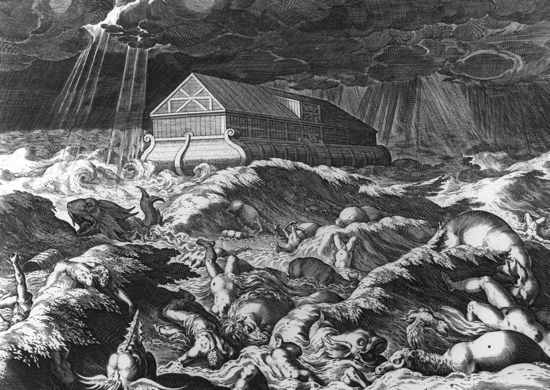
Inundations that wreck the settled life of people are common in history. Many cultural groups throughout the world have a tradition of folk tales that tell of traumatic flood events, but there is no reason to suppose they all happened at the same time, and there is no evidence to support the idea of a global flood.
In ancient Mesopotamia the environment was harsh – hot summers, little rainfall and rivers that flooded unpredictably. Yet the agriculture of that country depended on an annual flooding of the rivers to revitalize the soil, so many Sumerian cities were built near a flood plain. However, in some years the rivers did not flood enough, and in others they flooded too much. Around 3100 BC, the Euphrates spilled over much more than usual and swamped the city of Shuruppak, and a great deal of the region around it.
Shuruppak was a large and prominent city at that time. Today we would expect to see an instant inrush of rescue helicopters and humanitarian aid to the scene, but in 3,100 BC such things didn’t exist. There would have been much misery, but scant sympathy shown by others. The fate of the people in and around Shuruppak would have been viewed by outsiders as the punishment of the gods for their profanities and sinful ways.
Although in terms of world events it was only a local disaster, this flood had a profound impact on the Sumerians as a whole who, perhaps combining it with dimly recalled hand-me-down folk memories of the Black Sea flood, then dramatized it in their Genesis story Epic of Gilgamesh. It is from this account that the Jewish and Christian faiths drew the tradition of Noah’s Flood.
The Epic features an equivalent of Noah in a man called Utnapishtim, and the associated tale of animals being rescued ‘two by two’ could be construed as desperate herdsmen attempting to salvage some breeding stock, since such animals were their livelihood.
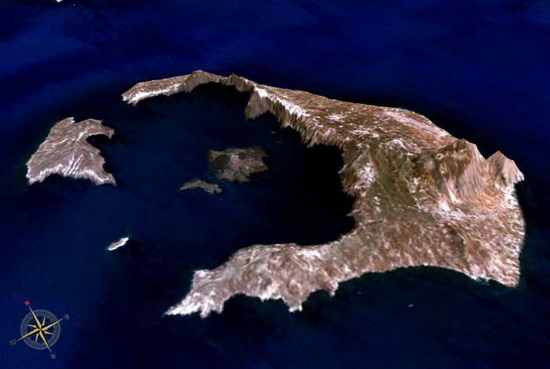
The eruption of the volcano on the island of Thera (now called Santorini) around 1600 BC has become a key marker for the Bronze Age, in the Eastern Mediterranean. It was probably the largest volcanic event in recorded history. The volcano literally exploded, destroying most of the island it had created, and sterilizing the bits that remained. Researchers say that during the ash fallout an area of at least 300,000 sq. km would have been plunged into total darkness, and sulphur discharged into the atmosphere would have caused significant cooling of the earths surface.
One immediate victim was the thriving Minoan city and port of Akrotiri, that had been established on Thera. Its awful fate may have inspired certain Greek myths, and given rise to Plato’s story of Atlantis. Although the inhabitants of Akrotiri had been evacuated before the final event, the massive tsunami caused by the eruption would have been catastrophic for the communities on the islands nearby, and those on the coast of Crete.
The subsequent volcanic winter probably contributed to the disorder in Egypt at this time, and it has even been blamed for the downfall of the Xia dynasty in ancient China, when: ‘there was a yellow fog, a dim sun, frost in July and the withering of all crops’. There are even those who claim that environmental conditions triggered by the Thera explosion were responsible for the string of 10 plagues in ancient Egypt that are recorded in the Bible.
The plagues preceded the exodus of the Israelites, and traditionalists believe the exodus to have occurred around 1450 BC. That is the subject of many scholarly debates, but radiocarbon dating (giving leeway for a few years either way) insists the Israelites sacked Jericho around 1562 BC, therefore their departure from Egypt could easily have been at the time of the Thera event.
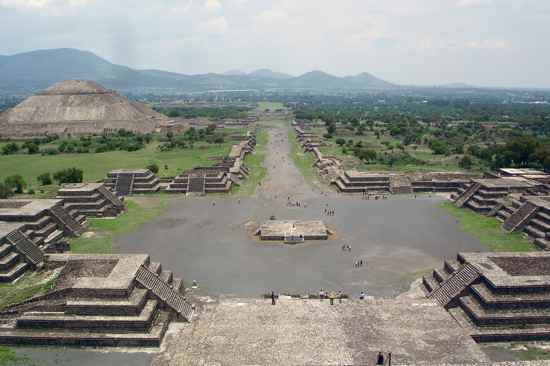
In 535-536 there was a severe episode of climate cooling, thought to have been caused by an extensive atmospheric dust veil from volcanic activity in the tropics. Science writer David Keys believes the cause was a volcanic super eruption equal to millions of Hiroshima size bombs. Its effects were certainly felt worldwide.
A Chinese court journal mentioned ‘a huge thunderous sound coming from the south-east’, while thousands of miles away a Hopi elder said, ‘there was a big noise heard all over the Earth’. The Pustaka Raja Purwa in Indonesia wrote, ‘then came forth a furious gale that darkened the entire world’. From Mongolia to Constantinople, chroniclers reported the sun lost its radiance and its warmth for almost two years, causing unseasonable weather and crop failures that precipitated plagues, famines and chaotic migrations.
Keys believes such calamities may have led to the fall of the great Mexican city of Teotihuacan, and could also have had a role in the birth of Islam, which became established less than a hundred years later. In addition, he hypothesizes they may have been a major factor in initiating the three hundred years of social turmoil in Europe, erroneously known as the Dark Ages but now known as the early Middle Ages.
The volcanologist R B Stothers favours the eruption of Rabaul in Papua New Guinea as the culprit in all this, while others believe it was an early super eruption of Krakatoa in Indonesia.
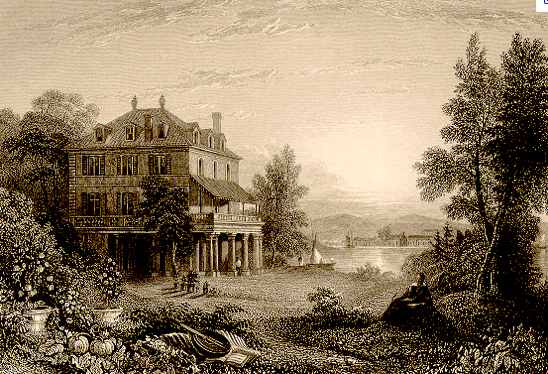
1816 was the ‘year without a summer’, and the following year is sometimes referred to as ‘eighteen hundred and frozen to death’. The cause was the eruption of Mount Tambora in Indonesia, in which the volcano violently exploded and precipitated the coldest year of the nineteenth century, and one of the coldest on record.
The blast was four times more powerful than that of Krakatoa and 52,000 times more powerful than the atom bomb dropped on Hiroshima, in 1945. In the Far East 92,000 people died, mainly from starvation due to the devastation of crops and animal life. Dust and sulphuric ash clouds propelled into the atmosphere cloaked sunlight, disrupted weather and caused global temperatures to drop for three consecutive years. In India, the annual monsoons failed to fall in their usual regions, leading to a massive epidemic of cholera among people compelled to rely on supplies of foul, stagnant water.
Europe was more affected than the USA, possibly because of the size of population rather than the weather conditions. Failure of crops led to food riots in France and Switzerland, and at least 200,000 people died in a typhus epidemic. Nevertheless, the near total destruction of harvests in New England led to the first mass migration of farmers to the mid-west, and changed the pattern of American agriculture for ever.
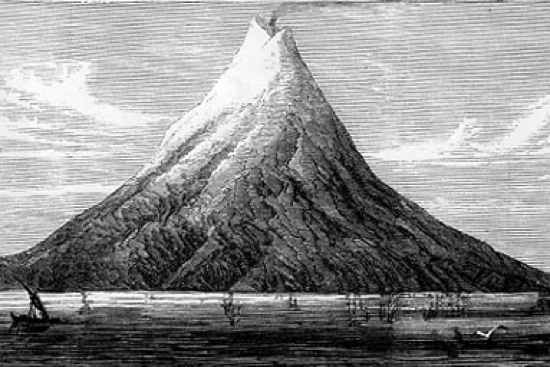
Krakatoa keeps cropping up, and since it is probably the most famous volcanic event in recent history, it has to be included. Krakatoa is a volcano on the island of Rakata, in the Sunda Strait between Java and Sumatra. On 27 August, 1883, the volcano exploded so violently that the noise was heard 3,500 miles away in Perth, Western Australia. Shock waves traveled around the globe 7 times, and clouds of ash were driven 80 km (50 miles) into the sky.
The 23km square island had existed to a height of 450m above sea level, but the blast leveled most of it to 250m below sea level. Pyroclastic flows destroyed voyaging ships 40km away. The combined effects of volcanic ash, pyroclastic flows (clouds of super-heated dust and gas which rip along the ground – or sea – at 100 mph), and the resulting 40m high tsunami had disastrous consequences for nearby small islands and coastal regions.
The official death toll in the immediate area was recorded as 37,000, but this only took into account those people on the coasts of Java and Sumatra. Some sources estimate the overall fatalities to have been four times that number. Global temperatures dropped by 1.2 Celsius, and world weather patterns remained chaotic for the next five years. Ominously, Krakatoa is still active and is slowly rebuilding itself. The ‘child of Krakatoa’ poked its head above the waves in 1930.
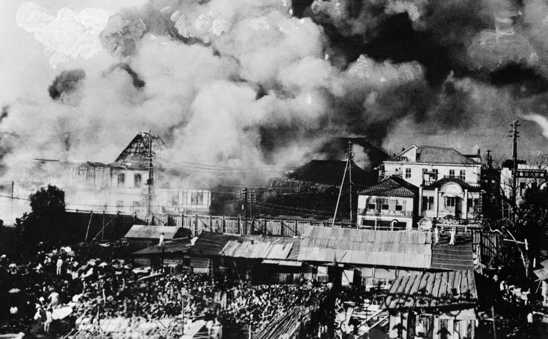
During the last thousand years earthquakes have been responsible for the deaths of at least eight million people worldwide. One of the biggest, measuring 8.3 on the Richter scale, occurred at Sagami Bay near Tokyo, in 1923. It was not the worse earthquake Japan had suffered, but because of its proximity to a high density of population, it was the most destructive.
Shock waves and falling debris in the city tipped over countless cooking stoves, and because the majority of the buildings were traditionally of wood and paper construction, they started millions of fires. Flammable materials in warehouses and industrial plants helped to fuel the flames, and, whipped up by the wind, the fires merged into a series of horrendous firestorms that lasted two days and two nights.
The well-trained fire service were helpless because broken water mains made water supply unavailable. 30,000 people trapped in the Honjo and Fukagawa districts sought refuge in a large open area, but ended up being incinerated there. When the fires finally burnt themselves out, Japan’s principle business districts were in ruins and up to 150,000 people had been killed, but while it was a national disaster for Japan, it went almost unnoticed by the rest of the world.
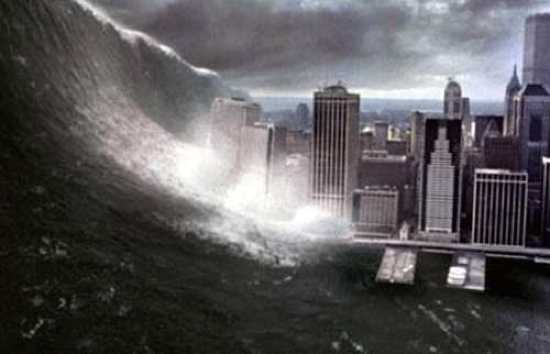
It is well known that the ground beneath Yellowstone National Park in Wyoming is a suitable candidate for a colossal super eruption that could equal the event at Lake Toba, over 70,000 years ago. Geo-hazard expert Bill McGuire has made a study of natural catastrophes and he believes there will be no let up of disasters in the future. Other possibilities he outlines include:
Mega-tsunami: The western coast of La Palma (Canary Islands) is primed to collapse into the sea. When this happens the eastern coastal cities of the USA will be struck by tsunamis 50m high.
Earthquake: Another major Tokyo earthquake on a par with that of 1923 would cause damage totaling $7 trillion, and could trigger a global economic collapse.
Asteroid Impact: A collision with an asteroid 1-1.5 kilometers in diameter would result in the deaths of at least a quarter of the worlds population. The survivors would be hurled back to a level of life consistent with the Middle Ages.
Possible Global Warming: By the end of the century the Earth may be hotter than at any time in the past 150,000 years. No one knows what consequences this would have.
Possible Global Cooling: Just 600 human generations have passed since the end of the last glacial period, but the planet could be priming itself for a return to full glacial conditions – remember, we are currently in an ice age called the Pleistocene glaciation. McGuire believes that all that is needed to induce rapid global cooling is a trigger, and ironically global warming could provide just such a trigger.
But hey, we shouldn’t worry too much. If any of this stuff is going to happen the chances are it’s not likely to be before December 2012!

